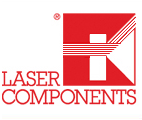Our experts have done a comparison: 520 nm laser diodes and 532 nm DPSS lasers.
Better FLEXPOINT® Laser Modules with Green Laser Diodes?
D77-074
It’s here! – The directly-emitting, semiconductor-based green laser diode can be integrated into our FLEXPOINT® laser modules as an alternative to miniature DPSS lasers. Our production team and our laser module sales team leader, Jochen Maier, are available to discuss what exactly has changed with the directly-emitting diodes. We offer a comparison between the 532 nm diode-pumped solid-state (DPSS) lasers and the 520 nm laser diodes, as well as personal experience reports provided by our experts!
For many years, we have been integrating small DPSS lasers into the FLEXPOINT® laser modules at LASER COMPONENTS. In the beginning, we fought with thermal problems and power stability; nowadays, DPSS technology is very stable and used in many industrial and medical applications.
Green: The brightest thing we have to offer the human eye!
Green light is perceived as the brightest light by the human eye! Thus, it makes sense that green lasers be used for applications in which the laser beam is meant to be observed by the naked eye. Using green cross-hairs and lines, we can position machines or parts; green dots show the doctor where the processing laser hits human tissue; in material processing, they show where material will be welded or separated.
Color sensitivity differs from person to person; however on a basic level, the 532 nm wavelength of the DPSS laser is perceived as a full and powerful green. The laser diodes currently available have a wavelength of 520 nm (i.e., a light blue streak that is perceived as colder).
Beam profile: Striking differences
If you continue to compare both technologies, the most striking differences can be found in the beam profile: Due to the underlying physics, the DPSS laser produces a uniform, round beam with a Gaussian-shaped power distribution and an M2 value of nearly 1.0. The semiconductor laser with its layer structure, however, emits an elliptical beam at a ratio of approximately 1:3. It is suited for making lines, and together with diffractive optical elements can generate diverse patterns. The DPSS laser remains the first choice for dot lasers – especially in the medical field.
Temperature range: Ice cold to hot
The first miniature DPSS lasers to enter the market had a very limited temperature range: values typically ranged between 10°C and 30°C or between 15°C and 40°C. The versions that are currently available range from -5°C to +50°C!
Laser diodes remain undefeated in our comparison:
Up to a power level of 50 mW, the 520 nm diodes offer a consistent operating temperature range of -20°C to +60°C.
The operating temperature applies to the laser source. If it is integrated into a housing, the additional heat produced in the housing must also be taken into consideration.
Power stability: Dependent upon heat generation
Heat generation significantly affects the power stability of the lasers: Miniature DPSS lasers are extremely temperature sensitive. With complex electronics, we are successful in stabilizing our FLEXPOINT® DPSS modules to power fluctuations of <5%. This requires DPSS lasers that are equipped with an additional photodiode by the manufacturer. This allows us to implement an effective control circuit to stabilize the optical power.
Power stabilization is unproblematic in modules with a directly-emitting laser diode: Monitoring diodes are integrated on a standard basis. In combination with the digital laser control developed by us, we can achieve power fluctuations of <2%.
Modulation behavior and Q-switch phenomenon
The digital modulation behavior and the analog power adjustment of miniature DPSS lasers are limited by the so-called Q-switch phenomenon: This is disruptive noise with very high peak intensities in the frequency range of 200 kHz to 2 MHz. In addition, another mode in the DPSS laser can develop, which results in a second output beam. This undesired effect occurs often at low power levels and, therefore, affects dimmable lasers. Both disruptive effects are very temperature dependent and often not reproducible. The maximum modulation frequencies of FLEXPOINT® DPSS laser modules are, therefore, limited to a few kHz and in some cases to less than 1 kHz.
Laser diodes of 520 nm do not exhibit the Q-switch phenomenon and can be modulated with >100 MHz depending on the control electronics. In simple laser modules, modulation frequencies with several hundred kHz to 2 MHz are common.
Dimensions: When size matters
If space is limited, you require laser diodes: The smallest available 520 nm laser diodes fit into a TO housing with a diameter of only 3.8 mm. The entire module, including control electronics, therefore, fits into a housing that has a diameter of 11.5 mm. It is possible to further miniaturize this module to just 6 mm! The housing length depends on the desired beam profile and the extent of the electronic controls.
The miniature DPSS lasers are largely available with a diameter of 10 mm or 12 mm. A few special versions have a reduced diameter of 5.6 mm. The housing length of DPSS lasers will always be larger than versions with a laser diode due to their complex design and the required beam shaping.
Output power
Laser diodes of 520 nm are currently available with an output power of up to 80 mW. Miniature DPSS lasers can achieve up to several hundred milliwatts.
Plummeting costs
The price of 520 nm laser diodes has been rapidly dropping since their market introduction. They are already less expensive than DPSS lasers with an output power of >10 mW. It can be assumed that the cost of green-emitting laser diodes will very soon match the cost of red-emitting laser diodes. Due to the electronic controls, which are much easier to handle than in DPSS lasers, the green laser diode is already the more cost-effective alternative.
Conclusion
Green laser diodes have been rapidly expanding and will dominate many areas of projection technology; nevertheless, the 532 nm DPSS lasers will remain the first choice in some applications. In particular, when the beam profile has priority, the DPSS laser can make the most of its advantages. If housing size, temperature, power stability, modulation behavior, or price is of particular importance, then green laser diodes are used.
DOEs for Changing the Beam Profile
Diffractive optics for changing the beam profile are now also available, specifically adjusted to green wavelengths.
Photonics Research in Germany
The Federal Ministry of Education and Research supports project partners in the advancement of technology as part of the “Optical Components and Systems for Volume Markets” funding initiative. MOLAS (December 1, 2007, to March 31, 2012) promoted technologies for ultra-compact and mobile laser projection systems with a project volume of 18.7 million euros. The PICOLO project (from July 1, 2012, to February 29, 2016) supported pico projection with RGB laser diodes in mobile end devices and automotive applications.
| DPSS Module | Laser Diode | |
|---|---|---|
| Wavelength | 532 nm | 520 nm |
| Beam profile | Gaussian beam | Elliptical-nearly 3:1 |
| Operation temperature | -5°C to 50°C | -20° to 60°C |
| Output power stability | <5% | <2% |
| Modulation frequency | <1 kHz | >100 MHz available |
| Output power, max. | >100 mW | 80 mW |
Datasheet:
Further product information:
Laser Modules
Manufacturer:
LASER COMPONENTS Germany / Laser Modules
Contact:
| Contact Person: | Stephan Krauß |
| Company: | Laser Components Germany GmbH |
| Address: | Werner-von-Siemens-Str. 15 |
| ZIP / City: | 82140 Olching |
| Phone: | +49 (0) 8142 2864-32 |
| Fax: | +49 (0) 8142 2864-11 |
| Email: | stephan.krauss@lasercomponents.com |
| |
|
























































